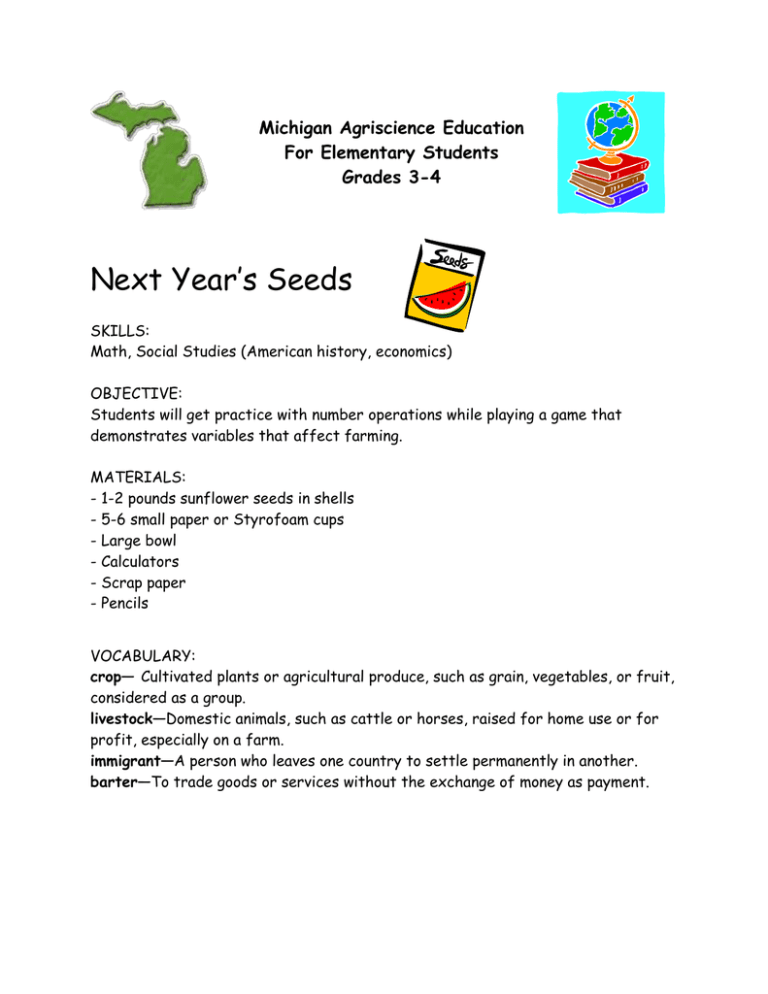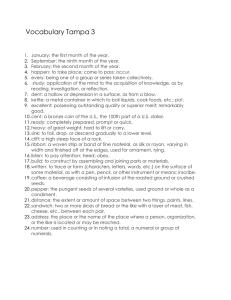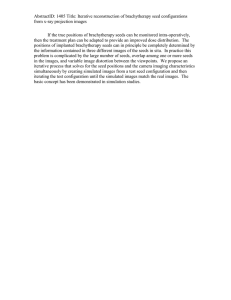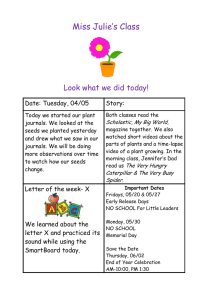Next Year’s Seeds Michigan Agriscience Education For Elementary Students
advertisement

Michigan Agriscience Education For Elementary Students Grades 3-4 Next Year’s Seeds SKILLS: Math, Social Studies (American history, economics) OBJECTIVE: Students will get practice with number operations while playing a game that demonstrates variables that affect farming. MATERIALS: - 1-2 pounds sunflower seeds in shells - 5-6 small paper or Styrofoam cups - Large bowl - Calculators - Scrap paper - Pencils VOCABULARY: crop— Cultivated plants or agricultural produce, such as grain, vegetables, or fruit, considered as a group. livestock—Domestic animals, such as cattle or horses, raised for home use or for profit, especially on a farm. immigrant—A person who leaves one country to settle permanently in another. barter—To trade goods or services without the exchange of money as payment. BACKGROUND: If you mow lawns to earn money in the summer, you probably know you can’t spend all you earn. Some of the money has to be set aside for buying gasoline to keep the lawn mower running. If you’re a really good business person, you’ll also set some money aside for repairs or even for buying additional equipment to expand your business. Farmers are the same way. Every time they earn money from the crops or livestock they produce, they have to put part of it back into the business. Some of the money goes to repair or replace equipment. Some of it goes to buy new equipment to improve next year’s crop. Some of the money buys fertilizer or seed. Our country’s first farmers didn’t sell their crops for money. Without advanced technology to help them, they were able to raise little more than what they needed to feed their families. If there was any left over they bartered with other farmers to get crops or livestock they didn’t raise themselves. In addition, a portion of every crop had to be set aside as seed so they could grow a new crop in the coming year. No matter how low the food supply got during the winter, they knew they had to stay out of the wheat, corn, barley or other seeds they had set aside to plant. Many immigrants carried seeds with them in pouches so they could get a good start in the New World. Seeds were not available like they are today, sold in colorful paper packages at the local grocery store. Even if they had been, there was little money available for buying them. Instead, early American farmers bartered with the Indians or other farmers to get what they needed. Sometimes they used catalogues to order seeds from England, but those were expensive. Over the winter seeds had to be stored in a cool, dry place, possibly in a cellar or in a sealed container buried underground. Careful farmers saved twice as much seed as they would need for the next year’s crop, just in case there was a crop failure. PRE-LAB: Have students divide a sheet of paper into two. On one side have them make a list of things farmers might need to buy for their farm. On the other side have them make a list of what farmers might sell to make money. PROCEDURE: Language Arts 1. Have students listen while you read the background information. Read each paragraph slowly, and stop to ask questions. 2. Provide copies of the Reading Page for students to read independently. Have students map or web the information and use a dictionary to look up highlighted words. 3. Have students write letters requesting free seed catalogs. (Search online for addresses.) 4. Have students discuss the saying “A penny saved is a penny earned” in relation to what they learned from playing the attached game. 5. Have students interview some older gardeners in your community to find out about seed saving practices. Math 1. Play the attached game, as follows: a. Make several copies of the situation cards printed on the following page, and cut them along the dotted lines. There are three sets of cards—one for practicing addition and subtraction, one for practicing multiplication and division and one for practicing percentages, fractions and decimals. (Hint: Laminate the cards after labeling each one on the back to indicate which set it belongs to. Keep the sets of laminated cards in plastic bags.) b. Divide your class into groups of five or six, and have each group sit in a circle. Assign a monitor for each group to hand out paper, pencils and calculators. Give each group one cup. One person from each group should count the group members and place five times that many seeds in the cup. Then have each group pass the cup around so each group member can take one seed to eat (or give it to someone else, or discard it. Throw away discarded seeds to avoid confusion). c. Explain that the seeds in the cup represent the year’s harvest, and that what remains in the cup represents the seeds needed to raise next year’s crop. d. After each member has taken one seed, have the last person count the number of seeds left in the cup and add two times that number to the cup. Then have the person sitting to that person’s left draw a situation card from the pile and follow the instructions printed on it. Make sure group members take turns following the instructions on the cards so all get a chance to do the necessary math. Numbers may be rounded off, if necessary. When there are not enough seeds left for every group member to have one, that group must drop out of the game. e. As in real life, students may run out of resources before they get very far into the game. At that point students must decide whether to borrow money so they can continue or quit the game. f. After the group has drawn all 10 of the cards, have the group figure its profit by counting how many seeds are left in the cup after each group member gets another one to eat. The group with the largest profit wins the game. 2. Have students make their own situation cards and repeat the game. 3. Play the game again, but have each group keep records of its gains and losses and create graphs to illustrate them. Social Studies 1. After students have finished playing the game (See Math.), lead a discussion about some of the real life situations faced by those responsible for growing food for all of us. Invite a farmer to class to answer questions. 2. Seeds and other food crops are sustainable natural resources. Have students list other natural resources that are sustainable (forests, people, animals, sustainable alternatives to fossil fuels) and what kinds of conservation methods would preserve them for the future students. 3. Have students discuss the expression “seed money” in terms of what they have learned about early farmers saving seeds for the coming year. 4. Discuss bartering. Have students discuss the value of having markets where seeds can be sold in exchange for dollars to buy other items. 5. Visit a nearby seed and feed mill. EXTRA READING: Demi, One Grain of Rice: A Mathematical Folk Tale, Scholastic, 1996. Greenwood, Barbara, and Heather Collins, A Pioneer Sampler: The Daily Life of a Pioneer Family in 1840, Ticknor & Fields, 1995. Lawlor, Laurie, Addie’s Dakota Winter, Whitman, 1991. Rendon, Marcie R., and Cheryl Walsh Bellville, Farmer's Market: Families Working Together, Carolrhoda, 2001. Stevens, Janet, Tops & Bottoms, Harcourt Brace, 1995. * Original can be found at Oklahoma Ag in the Classroom, www.clover.okstate.edu Handout 1 Next Year’s Seeds (Addition/Subtraction) Handout 2 Next Year’s Seeds (Multiplication/Division) Handout 3 Next Year’s Seeds (Fractions/Decimals/Percent) Handout 4 Reading Page Next Year’s Seeds Our country’s first farmers didn’t sell their crops for money. They didn’t have tractors and other machinery to help them. Most farmers raised just enough to feed their families. If there was any left over, they bartered with other farmers to get crops or livestock they didn’t raise themselves. A portion of every crop had to be saved as seed so they could grow a new crop the next year. No matter how low the food supply got during the winter, they knew they couldn’t eat the wheat, corn, barley or other seeds they had saved to plant. Many immigrants carried seeds with them in pouches so they could get a good start in the New World. Seeds were not available like they are today, sold in colorful paper packages at the grocery store. Even if they had been, there was little money for buying them. Instead, early American farmers traded with the Indians or other farmers to get the seeds they needed. Sometimes they used catalogues to order seeds from England. Those seeds were very expensive. Over the winter, seeds had to be stored in a cool, dry place, in a cellar or a sealed container buried underground. Careful farmers saved twice as much seed as they would need for the next year’s crop, just in case there was a crop failure.






